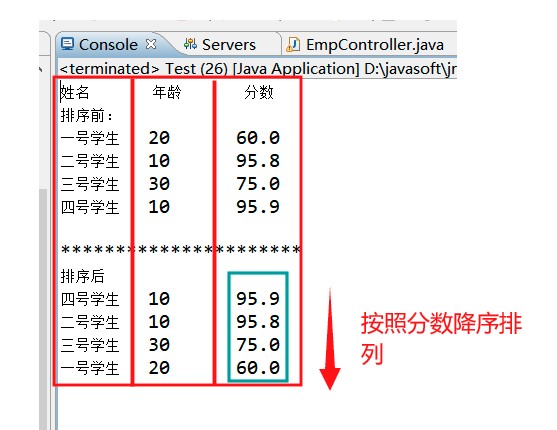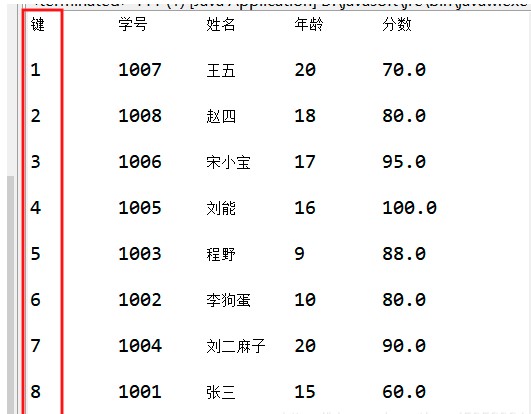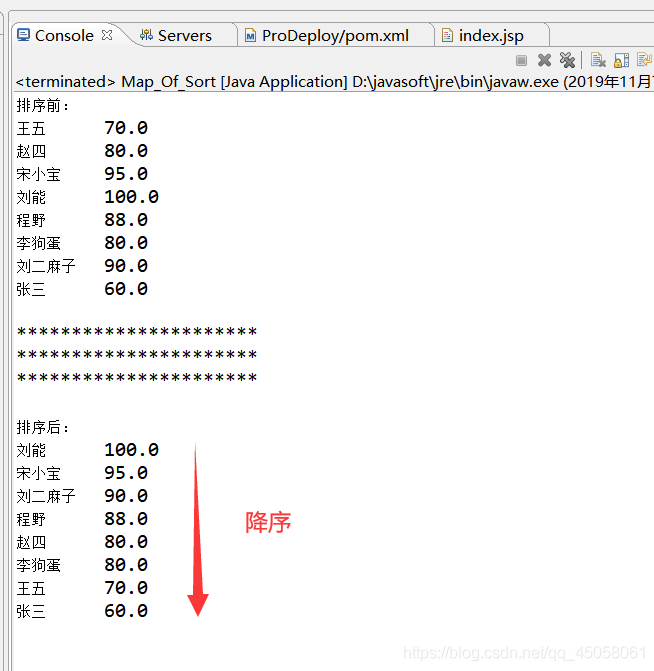Java集合排序的方式
- 2021-04-29 10:34:53
- 1057次 极悦
ArrayList集合排序:
集合中存放了学生对象,按照学生分数降序排序:
package cn.gf.exercise;
public class Stu {
private String stuno;
private String stuName;
private int age;
private double score;
//省略访问器
}
package cn.gf.exercise;
import java.util.ArrayList;
import java.util.Collections;
import java.util.Comparator;
public class Test {
public static void main(String[] args) {
// TODO Auto-generated method stub
//存放对象
Stu stu1 = new Stu();
stu1.setAge(20);
stu1.setScore(60);
stu1.setStuName("一号学生");
stu1.setStuno("001");
Stu stu2 = new Stu();
stu2.setAge(10);
stu2.setScore(95.8);
stu2.setStuName("二号学生");
stu2.setStuno("002");
Stu stu3 = new Stu();
stu3.setAge(30);
stu3.setScore(75);
stu3.setStuName("三号学生");
stu3.setStuno("003");
Stu stu4 = new Stu();
stu4.setAge(10);
stu4.setScore(95.9);
stu4.setStuName("四号学生");
stu4.setStuno("004");
ArrayList<Stu> stuList = new ArrayList<Stu>();
stuList.add(stu1);
stuList.add(stu2);
stuList.add(stu3);
stuList.add(stu4);
System.out.println("姓名 "+"\t"+" 年龄"+"\t"+" 分数");
System.out.println("排序前:");
for(Stu s: stuList) {
System.out.println(s.getStuName()+"\t"+s.getAge()+"\t"+s.getScore());
}
System.out.println("");
//参数1:要排序的集合
//参数2:排序规则,排序接口的实现类,在实现类中重写比较方法
Collections.sort(stuList,new Comparator<Stu>() {
@Override
public int compare(Stu o1, Stu o2) {
// TODO Auto-generated method stub
//需要明确比较的内容
/*按年龄排序的第一种方法
当年龄相等的时候再按照成绩排序
缺点:因为compare方法的返回值是int类型的,只适合整型的属性排序,所以不够灵活*/
// int i = o1.getAge() - o2.getAge();
// if(i == 0) {
// return (int) (o1.getScore() - o2.getScore());
// }
// return i;
//返回0:相等 返回1:o1>o2 返回-1:o1<o2
//只按年龄排序第2中方法
// if(o1.getAge()>o2.getAge()){
// return 1;
// }else if(o1.getAge()<o2.getAge()){
// return -1;
// }else{
// return 0;
// }
//按成绩
/*升序排序:大于配大值,小于配小值
* 降序排序:大于配小值,小于配大值
* (口诀:正序大配大,小配小;倒序相反)
*/
if(o1.getScore()>o2.getScore()) {
return -1;//大配小
}else if(o1.getScore()<o2.getScore()) {
return 1;//小配大,所以是降序排
}else {
return 0;
}
}
});
System.out.println("**********************");
System.out.println("排序后");
for(Stu s: stuList){
System.out.println(s.getStuName()+"\t"+s.getAge()+"\t"+s.getScore());
}
}
}

HashMap排序:
使用keySet()方法获取HashMap集合的key,并存入Set集合中,所存放的Set集合已是升序排好的(原因是存的时候按照hash值大小来存的)(键是升序排好的,但并不代表键对应的值是有序的):
package cn.gf.exercise;
import java.util.HashMap;
import java.util.Iterator;
import java.util.Set;
public class Map_Of_Sort {
public static void main(String[] args) {
HashMap<String,Stu> map = new HashMap<String, Stu>();
Stu s1 = new Stu("1001", "张三", 15, 60);
Stu s2 = new Stu("1002", "李狗蛋", 10, 80);
Stu s3 = new Stu("1007", "王五", 20, 70);
Stu s4 = new Stu("1004", "刘二麻子", 20, 90);
Stu s5 = new Stu("1008", "赵四", 18, 80);
Stu s6 = new Stu("1005", "刘能", 16, 100);
Stu s7 = new Stu("1006", "宋小宝", 17, 95);
Stu s8 = new Stu("1003", "程野", 9, 88);
/*
因为put的时候会根据hash算法计算当前key对应的hash值,
所以插入进去的“键值对”会根据hash值(键)的大小在数组中排序, HashMap是数组+链表结构,
所以当key为字符数字时,存的时候有序,取出来的key值也是有序的。
*/
map.put("8", s1);
map.put("7", s4);
map.put("1", s3);
map.put("6", s2);
map.put("5", s8);
map.put("4", s6);
map.put("3", s7);
map.put("2", s5);
Set<String> keys = map.keySet();
Iterator<String> it = keys.iterator();
System.out.println("键"+"\t"+"学号"+"\t"+"姓名"+"\t"+"年龄"+"\t"+"分数");
while(it.hasNext()) {
String next = it.next();
Stu s = map.get(next);
System.out.println();
System.out.println(next+"\t"+s.getStuno()+"\t"+s.getStuName()+"\t"+s.getAge()+"\t"+s.getScore());
}
}
}

HashMap集合中存放了学生对象,按照学生的分数降序排序:
思路:
1.通过map集合的entrySet()方法获取每一对 “键----值” 对(此方法返回一个Set集合)
2.使用ArrayList集合的构造方法,把Set集合转化成list集合(因为Collections.sort()方法中只能传入list集合)
3.调用Collections类的sort()方法,在sort()方法中自定义排序的规则
4.排序结束后map集合仍然是无序的,但是list集合是有序的(因为sort方法中传入的参数是list)
package cn.gf.exercise;
import java.util.ArrayList;
import java.util.Collections;
import java.util.Comparator;
import java.util.HashMap;
import java.util.Iterator;
import java.util.Map.Entry;
import java.util.Set;
public class Map_Of_Sort {
@SuppressWarnings("unlikely-arg-type")
public static void main(String[] args) {
HashMap<String,Stu> map = new HashMap<String, Stu>();
Stu s1 = new Stu("1001", "张三", 15, 60);
Stu s2 = new Stu("1002", "李狗蛋", 10, 80);
Stu s3 = new Stu("1007", "王五", 20, 70);
Stu s4 = new Stu("1004", "刘二麻子", 20, 90);
Stu s5 = new Stu("1008", "赵四", 18, 80);
Stu s6 = new Stu("1005", "刘能", 16, 100);
Stu s7 = new Stu("1006", "宋小宝", 17, 95);
Stu s8 = new Stu("1003", "程野", 9, 88);
map.put("8", s1);
map.put("7", s4);
map.put("1", s3);
map.put("6", s2);
map.put("5", s8);
map.put("4", s6);
map.put("3", s7);
map.put("2", s5);
//通过keySet()方法获取所有的键,并存入Set集合中
Set<String> keys = map.keySet();
//获取keys集合的迭代器
Iterator<String> it = keys.iterator();
while(it.hasNext()) {
/*
这样获取到的是null,会报错
Stu stu2 = map.get(it);
*/
//通过迭代器的.next()方法来获取key
String next = it.next();
//通过集合的.get(key)方法来获取当前键对应的值
Stu stu = map.get(next);
//输出未排序的集合
System.out.println(stu.getStuName()+"\t"+stu.getScore());
}
//通过map集合的entrySet()方法获取 键---值对 (获取map集合里的所有“映射”)
Set<Entry<String,Stu>> entrySet = map.entrySet();
/*编译错误:
The method sort(List<T>, Comparator<? super T>)
in the type Collections is not applicable for
the arguments (Set<Map.Entry<String,Stu>>, new Comparator<Object>(){})
意思是:sort()方法只能传入list集合,不能传set集合
*/
//通过ArrayList集合的构造方法,把set集合转为list集合
ArrayList<Entry<String, Stu>> list = new ArrayList<>(entrySet);
/*
调用Collections.sort(List<T>, Comparator<? super T>)方法,自定义排序规则。
Parameters:
list: the list to be sorted.
c: the comparator to determine the order of the list. A null value indicates that the elements' naturalordering should be used.
*/
Collections.sort(list, new Comparator<Entry<String, Stu>>() {
@Override
public int compare(Entry<String, Stu> o1, Entry<String, Stu> o2) {
// TODO Auto-generated method stub
if(o1.getValue().getScore()>o2.getValue().getScore()) {
return -1;
}else if(o1.getValue().getScore()<o2.getValue().getScore()) {
return 1;
}else {
return 0;
}
}
});
System.out.println("**********************");
System.out.println("**********************");
System.out.println("**********************");
//因为Collection.sort()方法中传入的是list集合,所以应该遍历list结合来判断排序是否成功
for(Entry<String, Stu> e: list) {
System.out.println(e.getValue().getStuName()+"\t"+e.getValue().getScore());
}
}
}

以上就是极悦小编介绍的"Java集合排序的方式"的内容,希望对大家有帮助,如有疑问,请在线咨询,有专业老师随时为您服务。
选你想看
你适合学Java吗?4大专业测评方法
代码逻辑 吸收能力 技术学习能力 综合素质
先测评确定适合在学习
在线申请免费测试名额
价值1998元实验班免费学
价值1998元实验班免费学












 在线咨询
在线咨询
 免费试学
免费试学